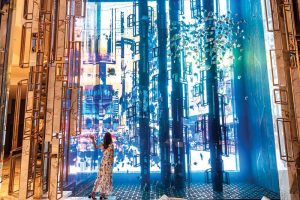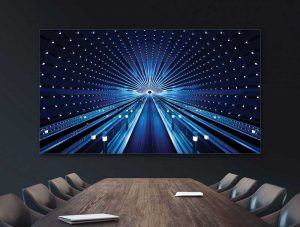Introducing the new digital canvas
by carly_mchugh | 6 September 2023 2:54 pm
 [1]
[1]In retail, there is high demand for stores to install direct-view LED displays, to entice consumers to enter. Photos courtesy Samsung Electronics Canada
By James Arndt
From boardrooms to shopping centres to stadiums, an emerging technology is taking over the digital signage space. With enhanced picture quality and brightness, glare-free viewing, flexible configurations, and no visual seams, direct-view LED is ushering in a new era of digital display possibilities.
Due to its growing popularity, direct-view LED is already being widely adopted in many markets, including corporate, retail, automotive, sports and entertainment, advertising, transportation, health care, and education. In fact, only five years ago, LED had limited applications, and displays such as video walls were rarely seen outside of trade show exhibits. Now, direct-view LED has become increasingly commonplace, with displays cladding buildings and embedded in everything from film and foil to commercial window glass.
What exactly is direct-view LED and what makes it so revolutionary?
LED versus LCD
Firstly, LED is short for light-emitting diode, a minuscule chip of light which produces the red, green, and blue lights that deliver the visuals on full-colour digital displays. The next generation of LED is called microLED, and it differs from its predecessors in that the light chips have become much tinier. This technology is also referred to as direct-view LED, because viewers look directly at the LED light source and its continuous blending of red, green, and blue light diodes. The LEDs both create the illumination and are the colour source for the entire image.
Alternatively, liquid crystal display (LCD) has been around a lot longer and is used in most flat panel displays. This technology uses white LED chips to illuminate an LCD layer that provides the visuals. The light chips are embedded inside the enclosure, behind the LCD layer, or along the edges. Unlike direct-view LED technology, viewers do not directly see the LEDs.
While there are variations in specifications for different products and types, direct-view LED displays are generally much brighter and have a higher contrast than their LCD counterparts. This means they are a great choice in natural light, outdoor, and brightly lit settings, as they can overcome the reflection and glare that often occurs in these scenarios—offering businesses and other users more versatility when it comes to where and when they want to use them.
 [2]
[2]With enhanced picture quality and brightness, glare-free viewing, flexible configurations, and no visual seams, direct-view LED is ushering in a new era of digital display possibilities.
Finally, perhaps the most important differentiator for direct-view LED—and one that explains its rising popularity—is best described in two words: no bezels. LCD video walls, including the most premium “extreme narrow bezel” ones, show hairline-thin vertical and horizontal gridlines which reveal where the individual LCD units are placed against each other. Properly installed direct-view LEDs have a uniform surface, with no evident gaps or lines showing between the individual modules. This allows today’s businesses to create large digital canvases with no visible gridlines, to provide a truly seamless viewing experience.
Direct-view LEDs also offer more flexibility than conventional LCD screens because of how they can be configured. With the exception of some specialty products, LCD units are uniform rectangles that can only scale to become larger rectangles when they are grouped as video walls. Meanwhile, direct-view LED displays have much smaller cabinets, which allows them to be grouped and tiled in different ways. For example, they can be arranged to cover curved arches at an entryway or be suspended face-down to create virtual digital ceilings. As a result, LEDs unlock new design possibilities and allow architects to think outside the (rectangular) box, by overcoming the constraints of older display technology in physical spaces.
 [3]
[3]Fine-pitch LED displays have been adopted in a wide variety of indoor settings, including airports.
Further, while there are many benefits to direct-view LED digital displays, it is also important to note the different types of technologies and product offerings, as well as their practical applications. In a corporate setting, bold feature walls could attract new office tenants and make existing ones want to stay, and seamless display walls are even replacing the classic projector displays in executive boardrooms. In retail, there is high demand for flagship stores to install direct-view LED displays outside to entice consumers to enter. They can also dial up the excitement by flanking entryways or creating whole facades that do away with more traditional store signage. Lastly, in transportation, auto manufacturers can create micro and satellite showrooms in unexpected locations, such as in shopping malls, on busy retail streets, or at the airport—removing any dependency on available inventory.
Indoor LED
Due to advances in digital display technology, LED is starting to replace LCD for video walls and other applications inside different venues. This is because the display cabinets are smaller and quieter, the displays manage power better (leading to lower operational costs), and serviceability and management are much easier than in past generations. Moreover, LED boasts a longer lifespan than LCD video wall screens, operating for years without significant degradation in performance or image quality. However, the real difference maker is how light chips are made and packaged for direct-view LED displays.
 [4]
[4]These new displays feature tightly spaced pixels, and are better suited for viewing up close, such as in a boardroom or lobby.
The most common LED technology used in indoor settings today is called surface mount diode (SMD) or package (PKG). It comprises red, green, and blue diodes packaged together in increasingly smaller dimensions, which has made it possible to pack light pixels closer together. Both indoor and outdoor LED products have a base rating of their pixel pitch, which is the measure of distance in millimetres between the centre of each LED package. Light pixels that are packed closer together, or have a fine pixel pitch, result in LED displays that look incredible from just a short distance away.
With enhanced picture quality and brightness, glare-free viewing, flexible configurations, and no visual seams, direct-view LED is ushering in a new era of digital display possibilities.
It is also important to understand the difference in price between LED displays is determined by the distance between pixels. Those that are more spaced out are more cost-efficient, and are best viewed from a greater distance, such as a storefront within a mall. Alternatively, displays with tightly spaced pixels are more costly and are better suited for viewing up close, such as in a boardroom or lobby. Fine-pitch LED displays have been adopted in a wide variety of other indoor settings, including in the concourses of sports arenas, airports, and conference centres. They are also being used as feature walls in skyscraper lobbies, big screens in sports bars, and marketing and promotional displays in flagship retailers.
Since costs have lowered and industry awareness has grown, LED has evolved from a specialty application to a popular option for any business owner or operator who wants to make a visual statement.
 [5]
[5]In a corporate setting, seamless display walls are replacing the classic projector displays in executive boardrooms.
Premium LED
In addition to SMD or PKG technology, indoor displays can also use chip-on-board (COB) or flip-chip manufacturing processes with microLED chips to create cutting-edge displays with exceptional picture quality on a massive scale. The appeal of this technology is evident by the increasing number of microLED products hitting the market.
On top of ensuring the proper level of protection for their digital signage, businesses must also consider one of the biggest industry challenges: installation. Among the decisions which need to be examined are the configuration between the control box and the cabinet, the pixel pitch, and the need to incorporate additional peripherals. This can ultimately cause delays in terms of researching, strategizing, and planning the deployment of a display. One way to combat this is to look for a pre-packaged solution that removes the typical hurdles. These options arrive pre-assembled, which simplifies the installation process by docking the background plates and hanging three or four preset modules, depending on the desired display size. Now, installation can be completed by two people in roughly two hours—eliminating a cumbersome configuration process.
Overall, the next generation of displays demonstrates how modular microLED technology can be custom-tailored to any size and aspect ratio, to immediately enhance the esthetic of a space. The tighter pixel pitches in these types of products mean they are ideally suited for close-range viewing in premium locations, such as luxury retail, corporate briefing centres, and executive offices. The displays can even be installed by homeowners who want a bold living room centrepiece or an impressive home theatre display.
Outdoor LED
When it comes to digital signage, being outdoors changes everything. Variable weather conditions, dust, pollution, and sunlight can affect the reliability of outdoor displays and, as such, they require different engineering than devices that look and work similarly indoors.
Outdoor displays are purposefully designed to work for years in everything from snow, wind, and rain to extreme temperatures. Ensuring their reliability in the elements is so important that outdoor displays are even measured on their ingress protection (IP) ratings to specify their level of protection against these factors. Beyond advertising signage, outdoor digital displays are being used for live game screens on the facades of sports venues, and to provide visitor information and directions at the entry gates of attractions and large venues.
From increased brightness and colour quality to flexible configuration capabilities and bezel-free, seamless pictures, it is no surprise direct-view LED displays are revolutionizing the digital signage space. In the near future, LED will become even more mainstream, and these full-motion displays will be everywhere. A new age of display technology has arrived, and thanks to direct-view LED, it is going to be a bright one.
James Arndt is the head of the enterprise business division at Samsung Electronics Canada, where he oversees sales, product management, and supply chain functions. His experience within the enterprise category, together with his 11-year tenure at Samsung, drives the division forward to deliver effective solutions to customers, as well as sustainable growth for the future.
- [Image]: https://www.signmedia.ca/wp-content/uploads/2023/09/5.jpg
- [Image]: https://www.signmedia.ca/wp-content/uploads/2023/09/1.jpg
- [Image]: https://www.signmedia.ca/wp-content/uploads/2023/09/3.jpg
- [Image]: https://www.signmedia.ca/wp-content/uploads/2023/09/2.jpg
- [Image]: https://www.signmedia.ca/wp-content/uploads/2023/09/4.jpg
Source URL: https://www.signmedia.ca/introducing-the-new-digital-canvas/